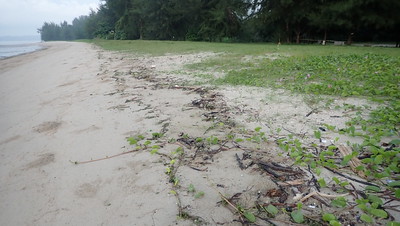This vast sandy shore is a habitat that is now rare in Singapore (thus 'lost') and home to animals that we seldom see on our other shores. This reclaimed shore in Changi East was in the past, remote and difficult to reach; thus 'lost' in yet another sense. As development started in the area, it became strictly off limits without a permit. We surveyed with permission kindly arranged by NParks.
Today, I was delighted to see seagrasses AND dugong feeding trails on the northern corner of the vast shore.
Before sunrise, I started at the southern corner of the shore and again saw dugong feeding trails in the seagrasses growing here. On the horizon, petrochemical flaring at Pengerang, Johor.
Here's a closer look at the feeding trail. Dugong feeding trails are formed when dugongs chomp up seagrasses including their roots, leaving a shallow meandering furrow of about equal width and depth.
Lush Spoon seagrass (large leaves and small leaves) grew in patches, with sprinkles of Needle seagrass. Kok Sheng saw a patch of Tape seagrass with long leaves, and also patches of Noodle seagrass.
I saw the usual animals commonly seen in our seagrass meadows: Haddon's carpet anemones, Orange-striped hermit crabs and lots of Noble volutes (mostly small, but I did see one large one). It was nice to see a Big-head seagrass octopus, which are common on other seagrassy areas in Changi.
Later on, I saw another Big-head seagrass octopus on a Grey bonnet snail. I'm not sure if it was eating the snail alive or already dead, or trying to use an empty shell.
Update: Dayna shared a photo showing that the octopus was using the shell to protect her eggs!
While the rest of the team survey the huge sandbars far out from the high shore, I surveyed the southern end of the shore which had a small sand bar. Predatory snails like moon snails are doing well here. There were many Egg-white moon snails and Oval moon snails - more easily distinguished by their underside. Other moon snails are easily identified by their distinctive upper shell or body markings: like Ball moon snails, Lined moon snail and China moon snail.
Other predatory snails include lots of busy Weasel olive snails and many Fig snails which were often contorted upside down or raising up high from the sand. I don't know why. There were also a few Gong gong snails buried in the sand. I saw one Grey bonnet snail on the bigger sand bar.
What do these predatory snails feed on? Probably tiny snails like Dubious nerites and Button snails, which are abundant. As well as buried clams of all kinds.Marcus saw a snake-eel hiding in a burrow in the sand!
Cake sand dollars remain super abundant - these are eaten by Bonnet snails. It was nice to see the Thick-edged sand dollars which are not common on our shores. There were also some Remarkable sea cucumbers.
It was a little disturbing to see Horse mussel beds on this shore. These mussels had taken over the shore at Changi Carpark 7 since 2019. The mussel bed creates a different habitat though, for animals like sponges, the Miliaris cowrie, Noble volute. As at Changi Carpark 7, there were also many large Fan shell clams among the mussels.Lots of 'pot holes' on the shore are probably created when stingrays forage for buried animals in the sand.
Surprisingly almost no litter washed up on the high shore. There was a lot during our survey on Jul 2021.
I first returned to this shore for the first time in ten years in Dec 2020. Recent trips were in Jul 2021 and Dec 2021. Previous trips to these shore were in Nov 2011, Oct 2011, quick visit in Oct 2011, Jan 2010, first trip in Jan 2010. This shore is now strictly off limits without a permit. We surveyed with permission kindly arranged by NParks.
What is the future of this shore?
According to the Long-Term Plan Review, this shore is slated for massive reclamation as a "Reserved Site" (yellow). So it will eventually be lost again.
Photos by others on this survey
Richard Kuah
Loh Kok Sheng
Marcus Ng
Vincent Choo
Che Cheng Neo
Dayna Cheah














